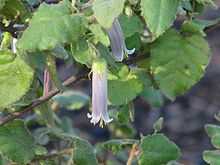Correa aemula
| Hairy Correa | |
|---|---|
 | |
| Scientific classification | |
| Kingdom: | Plantae |
| (unranked): | Angiosperms |
| (unranked): | Eudicots |
| (unranked): | Rosids |
| Order: | Sapindales |
| Family: | Rutaceae |
| Genus: | Correa |
| Species: | C. aemula |
| Binomial name | |
| Correa aemula (Lindl.) F.Muell. | |
| Synonyms | |
|
Didimeria aemula Lindl. | |
Correa aemula (Hairy Correa) is a shrub which is endemic to Australia.[1] It grows up to 2 metres in height. The elliptic leaves are densely hairy and are up to 7 cm long and 3 cm wide. [2] The pendent, tubular flowers are mainly produced between September and December in the species native range.[2] These are yellow or pale blue-green in colour.[2]
Taxonomy
The species was first formally described in 1838 by botanist John Lindley in Three Expeditions into the interior of Eastern Australia. He gave it the name Didimeria aemula. In 1858 another botanist Ferdinand von Mueller, transferred the species into the genus Correa.[3]
Distribution
Correa aemula occurs on sandy or rocky soils in open forests and heathy woodlands in the Mount Lofty Ranges and Kangaroo Island in South Australia and the Grampians in Victoria.[1][4][2] Hybrids with Correa decumbens and Correa reflexa have been recorded.[1]
References
- ↑ 1.0 1.1 1.2 "Correa aemula (Lindl.) F.Muell.". Electronic Flora of South Australia Fact Sheet. State Herbarium of South Australia. Retrieved 2009-05-06.
- ↑ 2.0 2.1 2.2 2.3 Wild Plants of Victoria CD-ROM. Bentleigh East, Victoria: Viridans Biological Databases & Department of Sustainability and Environment. 2003.
- ↑ "Correa aemula". Australian Plant Name Index (APNI), IBIS database. Centre for Plant Biodiversity Research, Australian Government, Canberra. Retrieved 2009-05-06.
- ↑ Wilson, Paul G. (1961). "A taxonomic revision of the genus Correa.". Transactions of the Royal Society of South Australia 85: 40–42. Retrieved 2009-12-31.